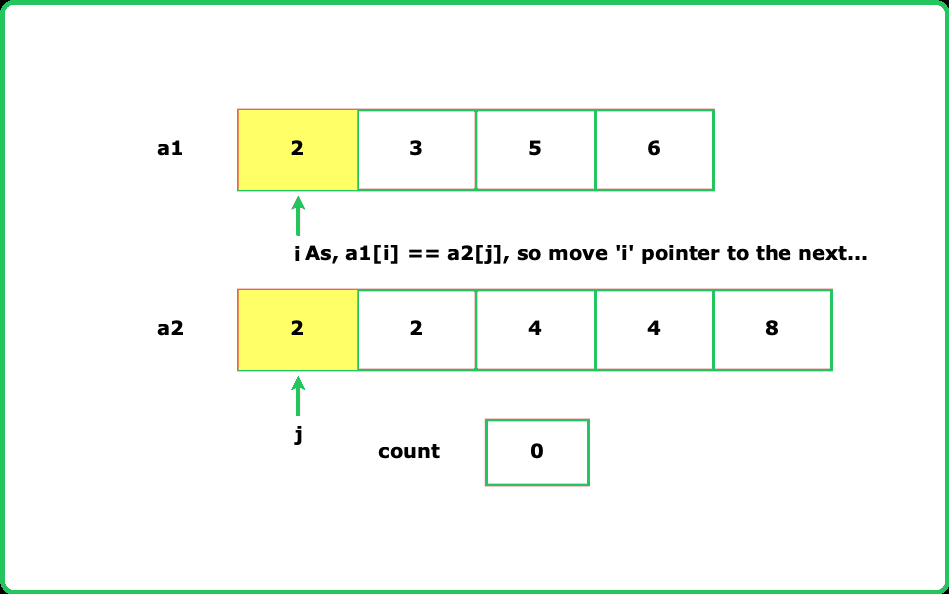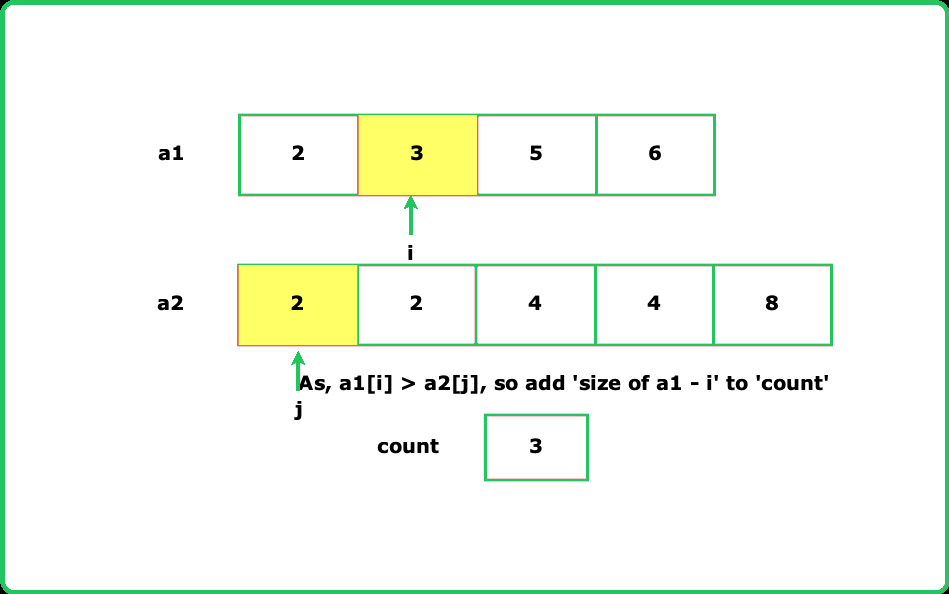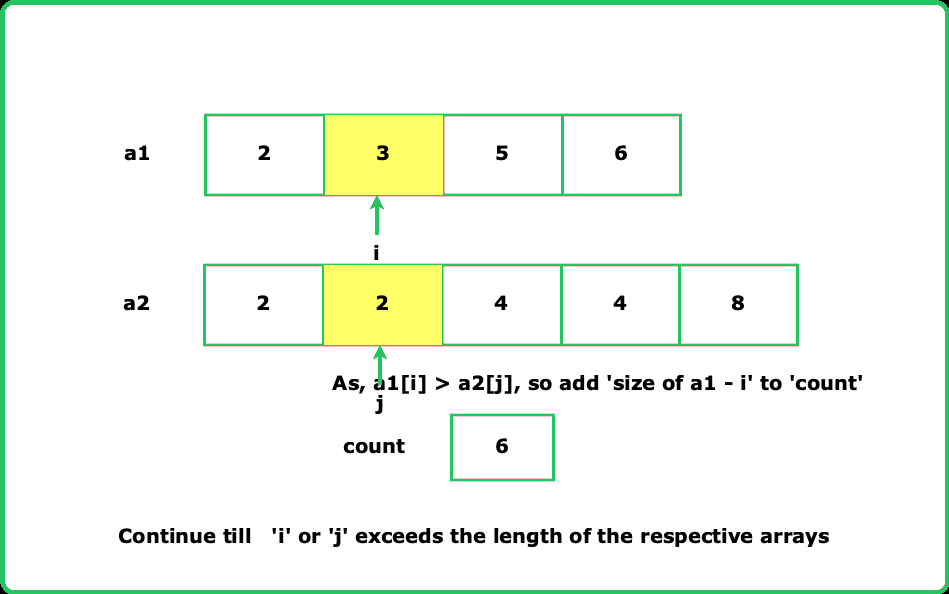123456789101112131415161718192021222324252627282930313233343536373839404142434445464748495051525354555657585960616263646566676869707172737475767778798081828384858687888990919293949596979899100101102
#include <bits/stdc++.h>
using namespace std;
class Solution {
private:
/* Merge function to count
inversions and merge sorted halves*/
long long int merge(vector<int>& arr, int low, int mid, int high) {
// Temporary array for merging
vector<int> temp;
// Starting indices of left and right halves
int left = low;
int right = mid + 1;
// Count variable to count the pairs
long long int cnt = 0;
// Merge sorted halves into temp array
while (left <= mid && right <= high) {
if (arr[left] <= arr[right]) {
temp.push_back(arr[left]);
left++;
}
else {
temp.push_back(arr[right]);
// Count inversions
cnt += (mid - left + 1);
right++;
}
}
// Copy remaining elements of left half
while (left <= mid) {
temp.push_back(arr[left]);
left++;
}
// Copy remaining elements of right half
while (right <= high) {
temp.push_back(arr[right]);
right++;
}
/* Copy elements from temp
array back to original array*/
for (int i = low; i <= high; i++) {
arr[i] = temp[i - low];
}
//return the count of inversions
return cnt;
}
// Merge sort function to recursively sort and count inversions
long long int mergeSort(vector<int>& arr, int low, int high) {
long long int cnt = 0;
if (low < high) {
int mid = low + (high - low) / 2;
// Sort left half
cnt += mergeSort(arr, low, mid);
// Sort right half
cnt += mergeSort(arr, mid + 1, high);
// Merge and count inversions
cnt += merge(arr, low, mid, high);
}
return cnt;
}
public:
// Function to find number of inversions in an array
long long int numberOfInversions(vector<int>& nums) {
// Size of the array
int n = nums.size();
// Count the number of pairs
return mergeSort(nums, 0, n - 1);
}
};
int main() {
vector<int> nums = {5, 4, 3, 2, 1};
// Create an instance of Solution class
Solution sol;
long long result = sol.numberOfInversions(nums);
// Print the number of inversions found
cout << "The number of inversions are: " << result << endl;
return 0;
}
1234567891011121314151617181920212223242526272829303132333435363738394041424344454647484950515253545556575859606162636465666768697071727374757677787980818283848586878889
class Solution {
/* Merge function to count
inversions and merge sorted halves */
private long merge(int[] arr, int low, int mid, int high) {
// Temporary array for merging
int[] temp = new int[high - low + 1];
// Starting indices of left and right halves
int left = low;
int right = mid + 1;
int index = 0;
// Count variable to count the pairs
long cnt = 0;
// Merge sorted halves into temp array
while (left <= mid && right <= high) {
if (arr[left] <= arr[right]) {
temp[index++] = arr[left++];
} else {
temp[index++] = arr[right++];
// Count inversions
cnt += (mid - left + 1);
}
}
// Copy remaining elements of left half
while (left <= mid) {
temp[index++] = arr[left++];
}
// Copy remaining elements of right half
while (right <= high) {
temp[index++] = arr[right++];
}
/* Copy elements from temp
array back to original array */
System.arraycopy(temp, 0, arr, low, high - low + 1);
// Return the count of inversions
return cnt;
}
// Merge sort function to recursively sort and count inversions
private long mergeSort(int[] arr, int low, int high) {
long cnt = 0;
if (low < high) {
int mid = low + (high - low) / 2;
// Sort left half
cnt += mergeSort(arr, low, mid);
// Sort right half
cnt += mergeSort(arr, mid + 1, high);
// Merge and count inversions
cnt += merge(arr, low, mid, high);
}
return cnt;
}
// Public function to find number of inversions in an array
public long numberOfInversions(int[] nums) {
// Size of the array
int n = nums.length;
// Count the number of pairs
return mergeSort(nums, 0, n - 1);
}
}
class Main {
public static void main(String[] args) {
int[] nums = {5, 4, 3, 2, 1};
// Create an instance of Solution class
Solution sol = new Solution();
long result = sol.numberOfInversions(nums);
// Print the number of inversions found
System.out.println("The number of inversions are: " + result);
}
}
123456789101112131415161718192021222324252627282930313233343536373839404142434445464748495051525354555657585960616263646566676869707172737475767778798081828384
class Solution:
# Merge function to count
# inversions and merge sorted halves
def merge(self, arr, low, mid, high):
# Temporary array for merging
temp = []
# Starting indices of left and right halves
left = low
right = mid + 1
# Count variable to count the pairs
cnt = 0
# Merge sorted halves into temp array
while left <= mid and right <= high:
if arr[left] <= arr[right]:
temp.append(arr[left])
left += 1
else:
temp.append(arr[right])
# Count inversions
cnt += (mid - left + 1)
right += 1
# Copy remaining elements of left half
while left <= mid:
temp.append(arr[left])
left += 1
# Copy remaining elements of right half
while right <= high:
temp.append(arr[right])
right += 1
# Copy elements from temp
# array back to original array
for i in range(low, high + 1):
arr[i] = temp[i - low]
# Return the count of inversions
return cnt
# Merge sort function to recursively sort and count inversions
def mergeSort(self, arr, low, high):
cnt = 0
if low < high:
mid = low + (high - low) // 2
# Sort left half
cnt += self.mergeSort(arr, low, mid)
# Sort right half
cnt += self.mergeSort(arr, mid + 1, high)
# Merge and count inversions
cnt += self.merge(arr, low, mid, high)
return cnt
# Function to find number of inversions in an array
def numberOfInversions(self, nums):
# Size of the array
n = len(nums)
# Count the number of pairs
return self.mergeSort(nums, 0, n - 1)
if __name__ == "__main__":
nums = [5, 4, 3, 2, 1]
# Create an instance of Solution class
sol = Solution()
result = sol.numberOfInversions(nums)
# Print the number of inversions found
print(f"The number of inversions are: {result}")
123456789101112131415161718192021222324252627282930313233343536373839404142434445464748495051525354555657585960616263646566676869707172737475767778798081828384858687888990919293
class Solution {
/* Merge function to count
inversions and merge sorted halves */
merge(arr, low, mid, high) {
// Temporary array for merging
const temp = [];
// Starting indices of left and right halves
let left = low;
let right = mid + 1;
// Count variable to count the pairs
let cnt = 0;
// Merge sorted halves into temp array
while (left <= mid && right <= high) {
if (arr[left] <= arr[right]) {
temp.push(arr[left]);
left++;
} else {
temp.push(arr[right]);
// Count inversions
cnt += (mid - left + 1);
right++;
}
}
// Copy remaining elements of left half
while (left <= mid) {
temp.push(arr[left]);
left++;
}
// Copy remaining elements of right half
while (right <= high) {
temp.push(arr[right]);
right++;
}
/* Copy elements from temp
array back to original array */
for (let i = low; i <= high; i++) {
arr[i] = temp[i - low];
}
// Return the count of inversions
return cnt;
}
// Merge sort function to recursively sort and count inversions
mergeSort(arr, low, high) {
let cnt = 0;
if (low < high) {
const mid = low + Math.floor((high - low) / 2);
// Sort left half
cnt += this.mergeSort(arr, low, mid);
// Sort right half
cnt += this.mergeSort(arr, mid + 1, high);
// Merge and count inversions
cnt += this.merge(arr, low, mid, high);
}
return cnt;
}
// Function to find number of inversions in an array
numberOfInversions(nums) {
// Size of the array
const n = nums.length;
// Count the number of pairs
return this.mergeSort(nums, 0, n - 1);
}
}
const nums = [5, 4, 3, 2, 1];
// Create an instance of Solution class
const sol = new Solution();
const result = sol.numberOfInversions(nums);
// Print the number of inversions found
console.log("The number of inversions are: " + result);





